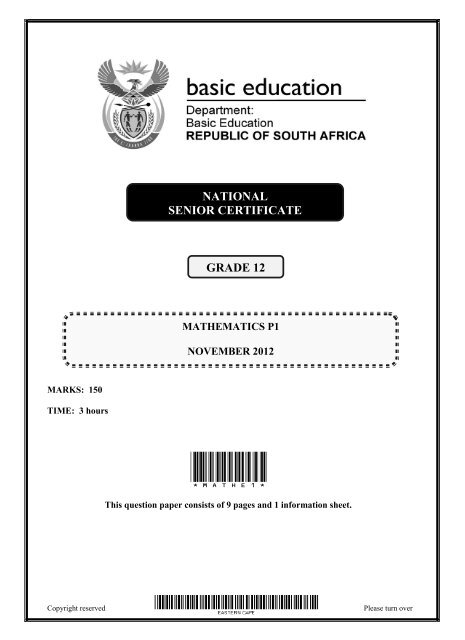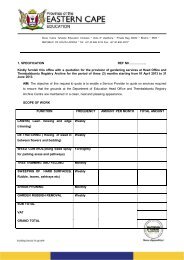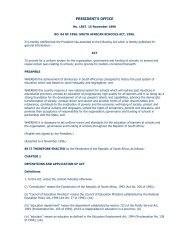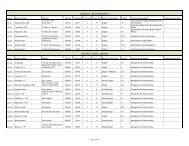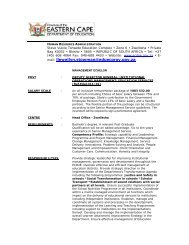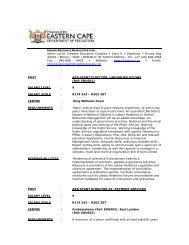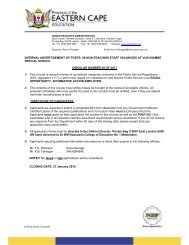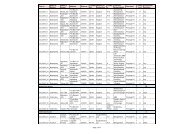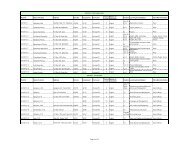Maths P1 English 2012
Maths P1 English 2012
Maths P1 English 2012
Create successful ePaper yourself
Turn your PDF publications into a flip-book with our unique Google optimized e-Paper software.
NATIONAL<br />
SENIOR CERTIFICATE<br />
GRADE 12<br />
MATHEMATICS <strong>P1</strong><br />
NOVEMBER <strong>2012</strong><br />
MARKS: 150<br />
TIME: 3 hours<br />
*MATHE1*<br />
This question paper consists of 9 pages and 1 information sheet.<br />
Copyright reserved<br />
Please turn over
Mathematics/<strong>P1</strong> 2 DBE/November <strong>2012</strong><br />
NSC<br />
INSTRUCTIONS AND INFORMATION<br />
Read the following instructions carefully before answering the questions.<br />
1.<br />
2.<br />
3.<br />
4.<br />
5.<br />
6.<br />
7.<br />
8.<br />
9.<br />
10.<br />
This question paper consists of 11 questions.<br />
Answer ALL the questions.<br />
Clearly show ALL calculations, diagrams, graphs, et cetera that you have used in<br />
determining your answers.<br />
Answers only will not necessarily be awarded full marks.<br />
You may use an approved scientific calculator (non-programmable and<br />
non-graphical), unless stated otherwise.<br />
If necessary, round off answers to TWO decimal places, unless stated otherwise.<br />
Diagrams are NOT necessarily drawn to scale.<br />
An information sheet with formulae is included at the end of the question paper.<br />
Number the answers correctly according to the numbering system used in this<br />
question paper.<br />
Write neatly and legibly.<br />
Copyright reserved<br />
Please turn over
Mathematics/<strong>P1</strong> 3 DBE/November <strong>2012</strong><br />
NSC<br />
QUESTION 1<br />
1.1 Solve for x in each of the following:<br />
1.1.1 2 1x 4<br />
0<br />
x (2)<br />
1.1.2 3x 2 x 5 (Leave your answer correct to TWO decimal places.) (4)<br />
2<br />
1.1.3 x 7x 8 0<br />
(4)<br />
1.2 Given: 4y x 4 and xy 8<br />
1.2.1 Solve for x and y simultaneously. (6)<br />
1.2.2 The graph of 4y<br />
x 4 is reflected across the line having equation<br />
y x . What is the equation of the reflected line? (2)<br />
1.3 The solutions of a quadratic equation are given by<br />
For which value(s) of p will this equation have:<br />
2 2 p 5<br />
x <br />
7<br />
QUESTION 2<br />
1.3.1 Two equal solutions (2)<br />
1.3.2 No real solutions (1)<br />
[21]<br />
2.1 3x + 1 ; 2x ; 3x – 7 are the first three terms of an arithmetic sequence. Calculate the<br />
value of x. (2)<br />
2.2 The first and second terms of an arithmetic sequence are 10 and 6 respectively.<br />
2.2.1 Calculate the 11 th term of the sequence. (2)<br />
2.2.2 The sum of the first n terms of this sequence is –560. Calculate n. (6)<br />
[10]<br />
Copyright reserved<br />
Please turn over
Mathematics/<strong>P1</strong> 4 DBE/November <strong>2012</strong><br />
NSC<br />
QUESTION 3<br />
3.1 Given the geometric sequence: 27 ; 9 ; 3 …<br />
3.1.1 Determine a formula for T<br />
n<br />
, the n th term of the sequence. (2)<br />
3.1.2 Why does the sum to infinity for this sequence exist? (1)<br />
3.1.3 Determine S<br />
<br />
. (2)<br />
3.2 Twenty water tanks are decreasing in size in such a way that the volume of each tank<br />
is 2<br />
1 the volume of the previous tank. The first tank is empty, but the other 19 tanks<br />
are full of water.<br />
Would it be possible for the first water tank to hold all the water from the other<br />
19 tanks? Motivate your answer. (4)<br />
3.3 The n th term of a sequence is given by T 2( 5)<br />
2 n<br />
n 18.<br />
3.3.1 Write down the first THREE terms of the sequence. (3)<br />
3.3.2 Which term of the sequence will have the greatest value? (1)<br />
3.3.3 What is the second difference of this quadratic sequence? (2)<br />
3.3.4 Determine ALL values of n for which the terms of the sequence will be<br />
less than –110. (6)<br />
[21]<br />
Copyright reserved<br />
Please turn over
Mathematics/<strong>P1</strong> 5 DBE/November <strong>2012</strong><br />
NSC<br />
QUESTION 4<br />
4.1<br />
x<br />
Consider the function f ( x)<br />
3.2 6.<br />
4.1.1 Calculate the coordinates of the y-intercept of the graph of f. (1)<br />
4.1.2 Calculate the coordinates of the x-intercept of the graph of f. (2)<br />
4.1.3 Sketch the graph of f in your ANSWER BOOK.<br />
Clearly show ALL asymptotes and intercepts with the axes. (3)<br />
4.1.4 Write down the range of f. (1)<br />
4.2<br />
2<br />
S(–2 ; 0) and T(6 ; 0) are the x-intercepts of the graph of f ( x)<br />
ax bx c and<br />
R is the y-intercept. The straight line through R and T represents the graph of<br />
g( x)<br />
2x<br />
d .<br />
y<br />
R<br />
f<br />
g<br />
S(2 ; 0) T(6 ; 0)<br />
0<br />
x<br />
4.2.1 Determine the value of d. (2)<br />
4.2.2<br />
2<br />
Determine the equation of f in the form f ( x)<br />
ax bx c . (4)<br />
4.2.3 If<br />
2<br />
f ( x)<br />
x<br />
4x<br />
12<br />
, calculate the coordinates of the turning point<br />
of f. (2)<br />
4.2.4 For which values of k will f ( x)<br />
k have two distinct roots? (2)<br />
Copyright reserved<br />
4.2.5 Determine the maximum value of<br />
f ( x)<br />
12<br />
h ( x)<br />
3 . (3)<br />
Please turn over<br />
[20]
Mathematics/<strong>P1</strong> 6 DBE/November <strong>2012</strong><br />
NSC<br />
QUESTION 5<br />
The graph of f ( x)<br />
27x<br />
for x <br />
The point P(3 ; –9) lies on the graph of f.<br />
y<br />
0<br />
x<br />
P(3 ; –9) 9)<br />
f<br />
5.1 Use your graph to determine the values of x for which f ( x)<br />
9<br />
. (2)<br />
5.2 Write down the equation of<br />
1<br />
f in the form ...<br />
y Include ALL restrictions. (3)<br />
1<br />
5.3 Sketch f , the inverse of f, in your ANSWER BOOK.<br />
Indicate the intercept(s) with the axes and the coordinates of ONE other point. (3)<br />
5.4 Describe the transformation from f to g if g(x) = 27 x , where x 0. (1)<br />
[9]<br />
QUESTION 6<br />
The graph of a hyperbola with equation y f (x)<br />
has the following properties:<br />
Domain: x R, x 5<br />
Range: y R, y 1<br />
Passes through the point (2 ; 0)<br />
Determine<br />
f x. [4]<br />
Copyright reserved<br />
Please turn over
Mathematics/<strong>P1</strong> 7 DBE/November <strong>2012</strong><br />
NSC<br />
QUESTION 7<br />
7.1 A business buys a machine that costs R120 000. The value of the machine depreciates<br />
at 9% per annum according to the diminishing-balance method.<br />
7.1.1 Determine the scrap value of the machine at the end of 5 years. (3)<br />
7.1.2 After five years the machine needs to be replaced. During this time,<br />
inflation remained constant at 7% per annum. Determine the cost of the<br />
new machine at the end of 5 years. (3)<br />
7.1.3 The business estimates that it will need R90 000 by the end of five years.<br />
A sinking fund for R90 000, into which equal monthly instalments must<br />
be paid, is set up. Interest on this fund is 8,5% per annum, compounded<br />
monthly. The first payment will be made immediately and the last<br />
payment will be made at the end of the 5-year period.<br />
Calculate the value of the monthly payment into the sinking fund. (5)<br />
7.2 Lorraine receives an amount of R900 000 upon her retirement. She invests this<br />
amount immediately at an interest rate of 10,5% per annum, compounded monthly.<br />
QUESTION 8<br />
She needs an amount of R18 000 per month to maintain her current lifestyle. She<br />
plans to withdraw the first amount at the end of the first month.<br />
For how many months will she be able to live from her investment? (6)<br />
[17]<br />
8.1 Determine f (x)<br />
from first principles if f ( x)<br />
2x 2 5 . (5)<br />
dy<br />
8.2 Evaluate if y x<br />
4 2x<br />
x<br />
<br />
3 . (3)<br />
dx<br />
5<br />
8.3 Given:<br />
g(<br />
x)<br />
<br />
x<br />
2<br />
x 2<br />
x 1<br />
8.3.1 Calculate g(x)<br />
for x 1. (2)<br />
8.3.2 Explain why it is not possible to determine g (1)<br />
. (1)<br />
[11]<br />
Copyright reserved<br />
Please turn over
Mathematics/<strong>P1</strong> 8 DBE/November <strong>2012</strong><br />
NSC<br />
QUESTION 9<br />
3 2<br />
9.1 The graph of the function f ( x)<br />
x<br />
x 16x<br />
16<br />
is sketched below.<br />
y<br />
f<br />
0<br />
x<br />
9.1.1 Calculate the x-coordinates of the turning points of f. (4)<br />
9.1.2 Calculate the x-coordinate of the point at which f (x)<br />
is a maximum. (3)<br />
2<br />
9.2 Consider the graph of g ( x)<br />
2x<br />
9x<br />
5 .<br />
9.2.1 Determine the equation of the tangent to the graph of g at x = –1. (4)<br />
9.2.2 For which values of q will the line y =–5x + q not intersect the parabola? (3)<br />
9.3 Given: h(<br />
x)<br />
4x<br />
3 5x<br />
QUESTION 10<br />
Explain if it is possible to draw a tangent to the graph of h that has a negative<br />
gradient. Show ALL your calculations. (3)<br />
[17]<br />
A particle moves along a straight line. The distance, s, (in metres) of the particle from a fixed<br />
2<br />
point on the line at time t seconds ( t 0 ) is given by s ( t)<br />
2t<br />
18t<br />
45 .<br />
10.1 Calculate the particle's initial velocity. (Velocity is the rate of change of distance.) (3)<br />
10.2 Determine the rate at which the velocity of the particle is changing at t seconds. (1)<br />
10.3 After how many seconds will the particle be closest to the fixed point? (2)<br />
[6]<br />
Copyright reserved<br />
Please turn over
Mathematics/<strong>P1</strong> DBE/November <strong>2012</strong><br />
NSC<br />
INFORMATION SHEET: MATHEMATICS<br />
b b<br />
2 4 ac<br />
x <br />
2a<br />
A P( 1<br />
ni)<br />
A P( 1<br />
ni)<br />
A P( 1<br />
i)<br />
n<br />
A P( 1<br />
i)<br />
n<br />
n<br />
<br />
i1<br />
1 n<br />
n<br />
<br />
i1<br />
n(<br />
n 1)<br />
i <br />
2<br />
n<br />
n1<br />
Tn<br />
ar<br />
ar<br />
1<br />
S<br />
n<br />
<br />
<br />
<br />
x 1<br />
i 1<br />
F <br />
i<br />
<br />
n<br />
<br />
r 1<br />
T n<br />
a ( n 1)<br />
d<br />
S 2a<br />
( n 1<br />
d <br />
; r 1<br />
n<br />
x[1 (1 i) ]<br />
P <br />
i<br />
f '(<br />
x)<br />
f ( x h)<br />
f ( x)<br />
lim<br />
h 0 h<br />
d ( )<br />
2<br />
( )<br />
2<br />
x1 x2<br />
y1<br />
y2<br />
<br />
x2 x1<br />
y<br />
2<br />
y1<br />
M<br />
; <br />
2 2 <br />
y mx c<br />
y y m x )<br />
2<br />
2 2<br />
x<br />
a y<br />
b r<br />
In ABC:<br />
sin<br />
cos<br />
a<br />
sin A<br />
<br />
area ABC<br />
b<br />
sin B<br />
1<br />
<br />
2<br />
<br />
1<br />
( x1<br />
c<br />
sin C<br />
ab.<br />
sin C<br />
m <br />
y<br />
x<br />
2<br />
2<br />
S<br />
<br />
y<br />
x<br />
a<br />
2<br />
b<br />
2<br />
c<br />
2<br />
2bc.<br />
cos A<br />
n<br />
2<br />
n<br />
)<br />
a<br />
; 1 r 1<br />
1<br />
r<br />
1<br />
1<br />
m tan<br />
<br />
<br />
sin.cos<br />
cos.<br />
sin sin<br />
<br />
sin.cos<br />
cos.<br />
sin <br />
<br />
<br />
cos.cos<br />
sin.<br />
sin cos<br />
<br />
cos.cos<br />
sin.<br />
sin <br />
2<br />
2<br />
cos<br />
sin <br />
<br />
2<br />
cos 2<br />
1<br />
2sin <br />
2<br />
2cos<br />
1<br />
( x ; y)<br />
( x cos<br />
y sin<br />
; y cos<br />
xsin<br />
)<br />
sin 2<br />
2sin.<br />
cos<br />
xi<br />
x<br />
<br />
2<br />
<br />
i1<br />
fx<br />
x<br />
n<br />
n(<br />
A)<br />
P( A)<br />
P(A or B) = P(A) + P(B) –P(A and B)<br />
n<br />
yˆ<br />
a bx<br />
S<br />
<br />
Copyright reserved<br />
b<br />
n<br />
<br />
x<br />
<br />
n<br />
<br />
2<br />
x ( y y)<br />
<br />
2<br />
( x x)


